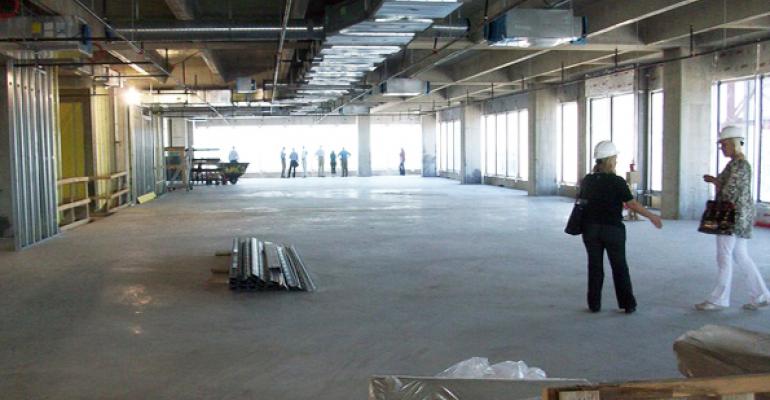According to the latest American Institute of Architects’ (AIA) Consensus Construction Forecast, conducted in December, the national building activity level for non-residential real estate is climbing. We spoke with AIA Chief Economist Kermit Baker to find out what’s behind the AIA’s prognosis. An edited transcript of that interview follows.
NREI: How does AIA monitor construction activity?
Kermit Baker: We run a Consensus Construction Forecast twice a year. We have seven or eight pros on the panel and we ask them to supply their topline forecast for non-residential building activity. We compile that and come up with the AIA Consensus, which is simply the average of all those numbers. We just did the most recent one at the end of the December, so the numbers are really pretty current. We break it down into commercial, institutional and industrial.
For commercial, we include offices, retail, hotels and other commercial activity, like banks. Industrial includes manufacturing facilities and related distribution facilities. Institutional is buildings that have either government or non-profit ownership; the biggest types of activity there are health and education, but we also ask for information on religious facilities, public safety facilities and amusement and recreation facilities.
Overall, forecast results on a construction spending basis is that overall activity for non-residential buildings is predicted to be up 7.7 percent in 2015 and 8.2 percent in 2016. In 2015, the commercial sector is projected to increase 11.8 percent, industrial to increase 10.5 percent and institutional to rise 5 percent. So they’re all pretty healthy numbers. Almost 8 percent growth would be a pretty good performance—not stellar, but good, and obviously it’s the strongest performance since the industry went into a recession at the end of 2008.
NREI: How does that compare with the lowest point?
Kermit Baker: Spending at the peak of the market in 2008 was exactly $500 billion. The trough was in 2011, when it was $337 billion. Our estimate, we don’t have final revised numbers in, but our estimate for 2014 is $377 billion. So it’s come back, but it’s certainly well below where it was before the downturn.
NREI: How will activity compare in different geographic regions?
Kermit Baker: My guess is that, broadly speaking, the South and the West that traditionally see the most construction activity had the largest overhang when the economy went into recession, so they saw the steepest declines for the inactivity [that] took place for the next few years. Now that their markets are recovering, they’re actually seeing the strongest growth, whereas the Northeast and Midwest were always a little more stable, both during the downside and now during the upswing. The strongest markets recently have been the Southcentral states—you know, Texas and the surrounding states—and then there has been some pretty healthy growth in California. In Florida, a little less so because it got hit so hard during the downturn; Atlanta was in that category too. Also Southcentral and the West Coast, particularly coastal California; some of the inland markets in California were pretty hard hit too because there was so much extra inventory there.
NREI: Do you see any dangers of overbuilding in any of the sectors?
Kermit Baker: I think there’s always danger of overbuilding, but we’re a long way from that now. The market is still well below where it was at the last peak. It’s probably not going to get back to that peak this cycle, but I would guess it would get fairly close to it. Market by market, you may see some imbalances, but I think, generally, overbuilding is not a problem. Multifamily, which we don’t include in this survey, may be the closest to that in the sense that its recovery began the earliest and it’s been very strong recently, so much so that multifamily construction activity is essentially where it was before the downturn. But single-family and all the non-residential categories are still well below.
NREI: Could you comment on the availability of financing for new construction?
Kermit Baker: We monitor that a little bit and we hear a lot about it from our members. Certainly, during the downturn, that was the most serious problem in achieving a recovery. Lenders just weren’t lending into the real estate market. I hear less of that now. There are reports from the Federal Reserve that lending standards have eased modestly with most lenders. It still is a problem, but not nearly as serious as it was two or three years ago.
In the non-residential sector, the critical piece is that the institutional market was negative and continued to be negative all the way through the end of last year. So those numbers have not begun to recover yet, that’s a very big piece of the total. Our architecture billings index measures design activity, which leads construction activity by nine to 12 months, and that has been turning up five months in the institutional sector. That means that architects are designing more institutional facilities. I think that’s a very encouraging sign that we’re likely to get a recovery this year in institutional building for the first time since the downturn. And that’s enough to really ensure that we’re going to have a stronger general non-residential recovery this year.

